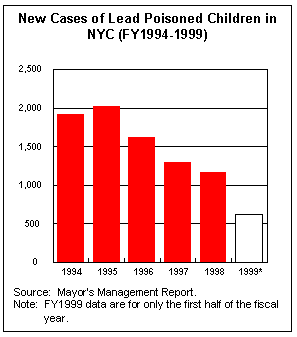
At an April 28th press conference held on the steps of City Hall, Councilmember Stanley Michels-Chairman of the Council's Committee on Environmental Protection¾released an IBO study on the fiscal impact of his bill (Intro. 205) to prevent lead poisoning of children. The study was prepared at Chairman Michels' request.
Despite the existence of a city law requiring landlords to fully remove or cover all lead-based paint in any dwelling unit occupied by a child under the age of 7, each year about 1,000 New York City children are still found to have elevated blood-lead levels. Childhood lead-poisoning can have serious health consequences, including anemia, learning disabilities, brain, kidney, and liver damage.
Although the current city law, known as Local Law 1, has been on the books since 1982, the city has regularly been sued for failing to enforce it. A lawsuit brought by the New York City Coalition to End Lead Poisoning (NYCCELP) resulted in a 1997 court order requiring the city to begin full implementation. As a result, both the Departments of Health and of Housing Preservation and Development wrote regulations, published in early 1999, to administer the law. The court issued a stay on implementation of the regulations until May 31, 1999, however, to give the City Council time to devise a legislative alternative. Chairman Michels' bill is one such alternative.
Intro. 205 proposes a lead paint hazard reduction standard of "lead-safe," requiring a lower level of remediation than Local Law 1's "lead-free" standard. In return for lowering the remediation standard, Intro. 205 sets higher requirements for inspection and enforcement in the future, to ensure that homes with children remain lead safe. In addition, Intro. 205 mandates removal of lead-based paint in public school buildings, in daycare centers, and from playground equipment. The bill also sets voluntary targets for blood screening of children.
IBO compared the costs of Chairman Michels' bill to full implementation of Local Law 1. We found that, compared with Local Law 1, Intro. 205 would save the city at least $5 million annually. The savings result from lower per unit costs for lead remediation and a smaller number of units that would require work. The bill would impose new inspection requirements on the Department of Housing Preservation and Development at a cost of less than $1 million annually. The bill also requires lead paint removal in schools, daycare centers, and playgrounds, although it appears that the costs from this requirement have for the most part already been incurred, or are already included in the city's budget and financial plan. Finally, the bill sets voluntary targets for screening children for blood-lead levels, which, if met, would result in some additional costs for screening and treatment under the city's share of Medicaid and uninsured reimbursements.
For 2000, HPD has set aside $38 million in its expense and capital budgets for lead paint programs. IBO estimates that Intro. 205 would cost an additional $2 million in 2000, compared with an additional $7 million that would be needed for full implementation of Local Law 1.
The report, Preventing Lead Poisoning in Children: Fiscal Impact of Intro. 205, a Legislative Alternative to Local Law 1, is available on our website or by calling IBO. For more information about this issue contact Preston Niblack at (212) 442-0220.
